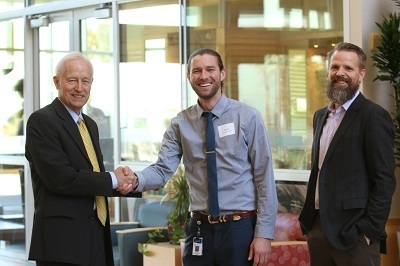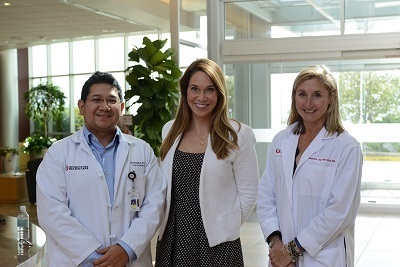Breadcrumb
Each year, Advancing Science in America (ARCS) awards $15,000 to a first-year John A. Moran Eye Center resident to seed promising research. Moran then matches the award for the following two years of residency, providing a total of $45,000 for a young researcher.
ARCS 2017 ophthalmology awardee Bradley H. Jacobsen, MD, plans to use the funds to focus on his research interest: the retina and the treatment of retinoblastoma a type of eye cancer most common in children.
"Without the ARCS scholarship, residents have to put their research on hold," explained Moran CEO Randall J Olson, MD, at the annual ARCS award luncheon. "We understand that hope in medicine lies in future innovation, in the passion of young researchers."
Photo caption: Randall J Olson, MD, CEO, Moran Eye Center; Bradley H. Jacobsen, MD, ARCS 2017 Scholar; Jeff Pettey, MD, Director of Moran Residency Education.
Jacobsen earned his medical degree from the University of California, Irvine School of Medicine and completed a general surgery residency at Baylor College of Medicine.
At UC Irvine, Jacobsen founded the International Ultrasound Project, which uses medical students to teach ultrasound and conduct research in Mwanza, Tanzania. He also received a $60,000 John Tu grant to initiate what has now become an integrated medical education course at a Mwanza medical school.
Jacobsen's many research projects range from investigating alternative treatments for patients with retinoblastoma to the feasibility of using ultrasound as a diagnostic imaging device in low-resource settings. He plans to continue his research at Moran, combining it with his passion for furthering high-quality care in underserved and resource-limited areas.

Rebekah Gensure, MD, PhD, received the 2016 ARCS Award. Currently, Gensure is working with Moran retina specialist Paul S. Bernstein, MD, PhD, on an investigational ophthalmologic imaging camera from Heidelberg Engineering called FLIO (Fluorescence Lifetime Imaging Ophthalmology). FLIO is non-invasive and measures the decay patterns of areas of the retina in response to two different wavelengths of fluorescent light. With FLIO, they have identified a notoriously difficult to diagnose hereditary disease that causes central vision loss called macular telangiectasia type 2 (MacTel).
Photo caption: Randall J Olson, MD, CEO, Moran Eye Center; Laura Springhetti, ARCS Utah Chapter Past President; Karen Gunn, ARCS Foundation Utah Chapter President; Rebekah Gensure, MD, PhD, 2016 ARCS Scholar.

Moran's 2015 awardee, Nikko Ronquillo, MD, PhD, is also currently working with Bernstein on the genetics of MacTel. He is collecting the largest families that have multiple affected individuals with MacTel and studying their inheritance pattern.
Photo Caption Nikko Ronquillo, MD, PhD, 2015 ARCS Scholar; Laura Springhetti, ARCS Utah Chapter Past President; Barbara Wirostko, MD, Moran Resident Research Director.